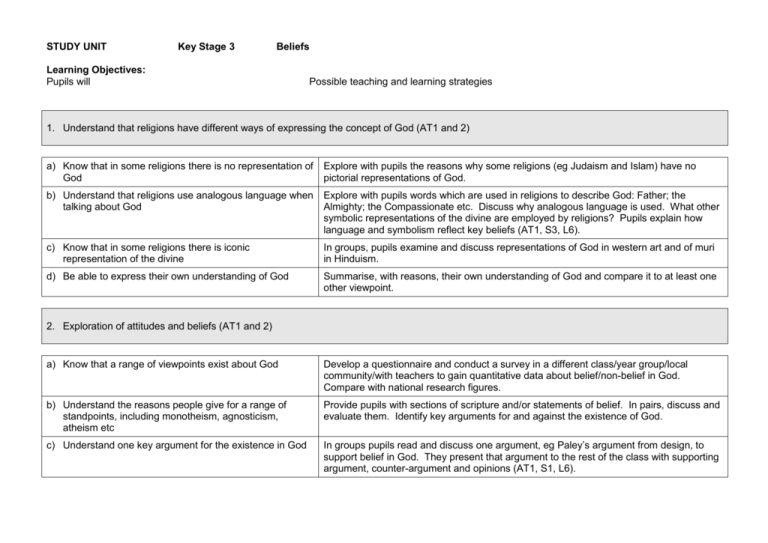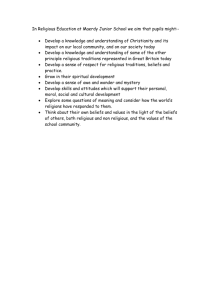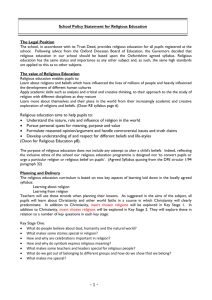EducationBradford
advertisement

STUDY UNIT Key Stage 3 Beliefs Learning Objectives: Pupils will Possible teaching and learning strategies 1. Understand that religions have different ways of expressing the concept of God (AT1 and 2) a) Know that in some religions there is no representation of God Explore with pupils the reasons why some religions (eg Judaism and Islam) have no pictorial representations of God. b) Understand that religions use analogous language when talking about God Explore with pupils words which are used in religions to describe God: Father; the Almighty; the Compassionate etc. Discuss why analogous language is used. What other symbolic representations of the divine are employed by religions? Pupils explain how language and symbolism reflect key beliefs (AT1, S3, L6). c) Know that in some religions there is iconic representation of the divine In groups, pupils examine and discuss representations of God in western art and of muri in Hinduism. d) Be able to express their own understanding of God Summarise, with reasons, their own understanding of God and compare it to at least one other viewpoint. 2. Exploration of attitudes and beliefs (AT1 and 2) a) Know that a range of viewpoints exist about God Develop a questionnaire and conduct a survey in a different class/year group/local community/with teachers to gain quantitative data about belief/non-belief in God. Compare with national research figures. b) Understand the reasons people give for a range of standpoints, including monotheism, agnosticism, atheism etc Provide pupils with sections of scripture and/or statements of belief. In pairs, discuss and evaluate them. Identify key arguments for and against the existence of God. c) Understand one key argument for the existence in God In groups pupils read and discuss one argument, eg Paley’s argument from design, to support belief in God. They present that argument to the rest of the class with supporting argument, counter-argument and opinions (AT1, S1, L6). d) Understand one key argument against the existence of God Pupils read and discuss one argument, eg the existence of suffering, to support agnosticism or atheism. Agree ground rules prior to discussion to ensure respect for different beliefs and worldviews, including Humanism. e) Be able to articulate their own beliefs In group or class discussion, or in writing, pupils give reasons for their beliefs. Reflect on the relevance of religions in developing their understanding of themselves and their experiences (AT2, S4, L6). 3. Understand that a range of beliefs exist about life after death (AT1) a) Know that a variety of standpoints exist on life after death Pupils identify such beliefs and choose one to research in depth, including a scriptural evidence and doctrinal teachings, recognising that different views exist within as well as between religions. Prepare and give a PowerPoint presentation to rest of class (AT1, S1, L6). b) Understand the reasons for beliefs about life after death Pupils explore reasons for beliefs from a range of sources. Discuss in pairs. c) Be able to explain their own beliefs about life after death Organise a circle debate in which two concentric circles of chairs are placed in the classroom: pupils have two minutes each to talk to the person opposite to explain their views. Pupils have exchanges with three or four other pupils. Summarise their own position, with reasons and reference to religious teachings, noting any changes in their thinking as a result of their work (AT2, S5, L6). d) Know that questions about life and death are found in literature and music At home, pupils tape record songs or find stories or poems which deal with belief in God or questions about life after death and bring them to lessons to share. 4. Attitudes to and ceremonies surrounding death (AT1) a) Understand attitudes towards and teachings on death Explore the euphemisms used about death and the reasons for their existence. Interview representative of religions or other world views about attitudes to death. b) Understand the symbolic significance of rituals Identify and research key rituals, symbols and their significance, including Humanist funerals. c) Be able to express their own views about death and rituals Through writing or creative arts, express their own responses to death.






![afl_mat[1]](http://s2.studylib.net/store/data/005387843_1-8371eaaba182de7da429cb4369cd28fc-300x300.png)
